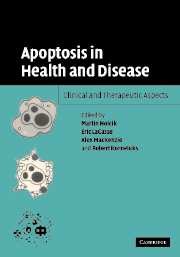Book contents
- Frontmatter
- Contents
- List of contributors
- Preface
- 1 Apoptosis in health, disease, and therapy: overview and methodology
- 2 Developmental apoptosis in health and disease
- 3 Apoptosis and cancer
- 4 Neuronal cell death in human neurodegenerative diseases and their animal/cell models
- 5 Apoptosis in the cardiovascular system: incidence, regulation, and therapeutic options
- 6 Cytotoxic lymphocytes, apoptosis, and autoimmunity
- 7 Pro- and anti-apoptotic strategies of viruses
- Index
- Plate section
- References
3 - Apoptosis and cancer
Published online by Cambridge University Press: 03 March 2010
- Frontmatter
- Contents
- List of contributors
- Preface
- 1 Apoptosis in health, disease, and therapy: overview and methodology
- 2 Developmental apoptosis in health and disease
- 3 Apoptosis and cancer
- 4 Neuronal cell death in human neurodegenerative diseases and their animal/cell models
- 5 Apoptosis in the cardiovascular system: incidence, regulation, and therapeutic options
- 6 Cytotoxic lymphocytes, apoptosis, and autoimmunity
- 7 Pro- and anti-apoptotic strategies of viruses
- Index
- Plate section
- References
Summary
Introduction
The body of knowledge concerning apoptosis and the molecular mechanisms involved in this cellular process continues to expand at an unprecedented rate. This knowledge has impacted not only on our understanding of cancer development, but also on diagnosis and treatment approaches for malignant diseases. This chapter summarizes some of the ways in which tumor cells have successfully corrupted cell survival and death machinery in order to evade the penalty of apoptosis. This is followed by a discussion of novel therapeutics that have begun to emerge and which are designed to address directly these mechanistic changes that can confound current treatment regimens. The advent of current technologies such as laser capture micro-dissection of tumor tissues and microarray expression profiling have also allowed for accurate diagnosis of cancer genotypes. With these and other technologies, the potential now exists to develop new treatment regimens that can directly target individual tumor susceptibilities and, further, to predict the likelihood of response of a particular tumor to specific treatments. Together, advances in the field of apoptosis research have resulted in a revolution in the design of novel anti-cancer therapeutics for cancer treatment. In future, diagnosis of the nature of the anti-apoptotic lesions within a given tumor cell could be directly translated into a rational treatment strategy to eradicate cancers.
Defining cancer in apoptotic terms
The word “cancer” has evolved to become an umbrella term which encompasses the many incarnations of the disease.
- Type
- Chapter
- Information
- Apoptosis in Health and DiseaseClinical and Therapeutic Aspects, pp. 75 - 95Publisher: Cambridge University PressPrint publication year: 2005



